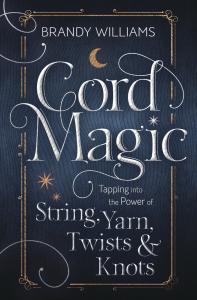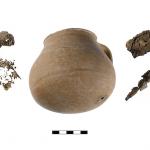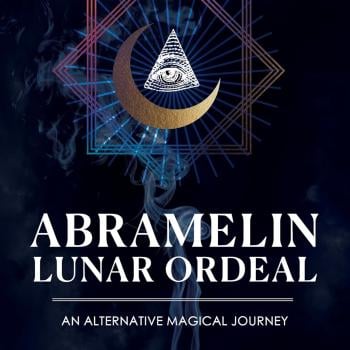Review of Cord Magic: Tapping into the Power of String, Yarn, Twists & Knots by Brandy Williams

Brandy Williams’ Cord Magic is a text of practical magic in which she shows “how to quickly and effectively twist your own magical cords, with specific tips for choosing colors, setting your intention, charging the cords, and incorporating powerful knot spells.” These magical cords can be used for virtually any purpose you can imagine including “protection, transitions, finding new love, improving your creative life, celebrating a handfasting, and many more.”
Being a bit of a history buff, I was pleased to find that Ms Williams traces cords, and possibly cord magic, to Neanderthals 90,000 years ago, in what is now France.
The next instance she discusses is in a Russian cave, where a 30,000 years old thread dyed a turquoise color was found. Plant roots were discovered nearby which could have been used for dyeing in a number of colors, including “yellow, red, blue, violet, black, brown, green, and khaki.”
The final ancient account is in Babylon, where red, white and black dyed cords were threaded with stone beads, and used in court cases, as well as protection from “disease, enemies, and the anger of the gods.”
Ms Williams points out that while “gemstone magic is well understood … the cord itself carries power … dyeing a cord enhances its power.” It makes a lot of sense to combine the two.
Ms Williams cites examples to show that cord magic has crept into “Jewish, Hindu, Buddhist, Christian, Shinto, and Pagan traditions.” However, “Christian and Jewish families may prefer not to think of these as magical actions but instead carrying the blessings of God for the recipients.” So, regardless of your spiritual tradition, chances are the you have been exposed to cord magic, perhaps without realizing it.
Charging a cord is simple. “Spinning fiber imparts energy into the thread.” Energy can be sent out by twisting away from the body, while conversely, energy can be kept in by twisting towards the body.
Ms Williams discusses how to determine the number of threads to be used and their colors. She provides worksheets for you to fill in with the associations you have for numbers and colors. Make sure you use a pencil on these! Ms Williams actually goes into the meanings of the numbers and colors later in the book, so you may find yourself changing some of your associations. Also, as you become more proficient with cord magic, you may find that your own personal associations differ from the norm, or what you first thought they should be.
The number seven is very important to me, and I was intrigued by Ms Williams’ proposal of creating a cord for protection using the seven planetary colors which correspond (in part) to the seven directions – north, south, east, west, center, up and down – which would constitute a “three- dimensional box or sphere of energy.” I fully expect readers to have sections of text jump out at them, like this did with me!
Ms Williams’ text is incredibly comprehensive as she discusses home made dyes, different types of fiber, the history of fabrics, examples of spells, and timing of rituals. There is a surprising amount of data to process.
The bottom line is the cord magic can be very simple and intuitive. Practitioners, however, have the option of adding more and more layers of complexity, all of which are discussed. Regardless of whether you like your magic simple or complex, cord magic can be adapted accordingly. It is also very versatile and can also be incorporated into virtually any spiritual modality.
Tony Mierzwicki
Author of Hellenismos: Practicing Greek Polytheism Today and Graeco-Egyptian Magick: Everyday Empowerment.












